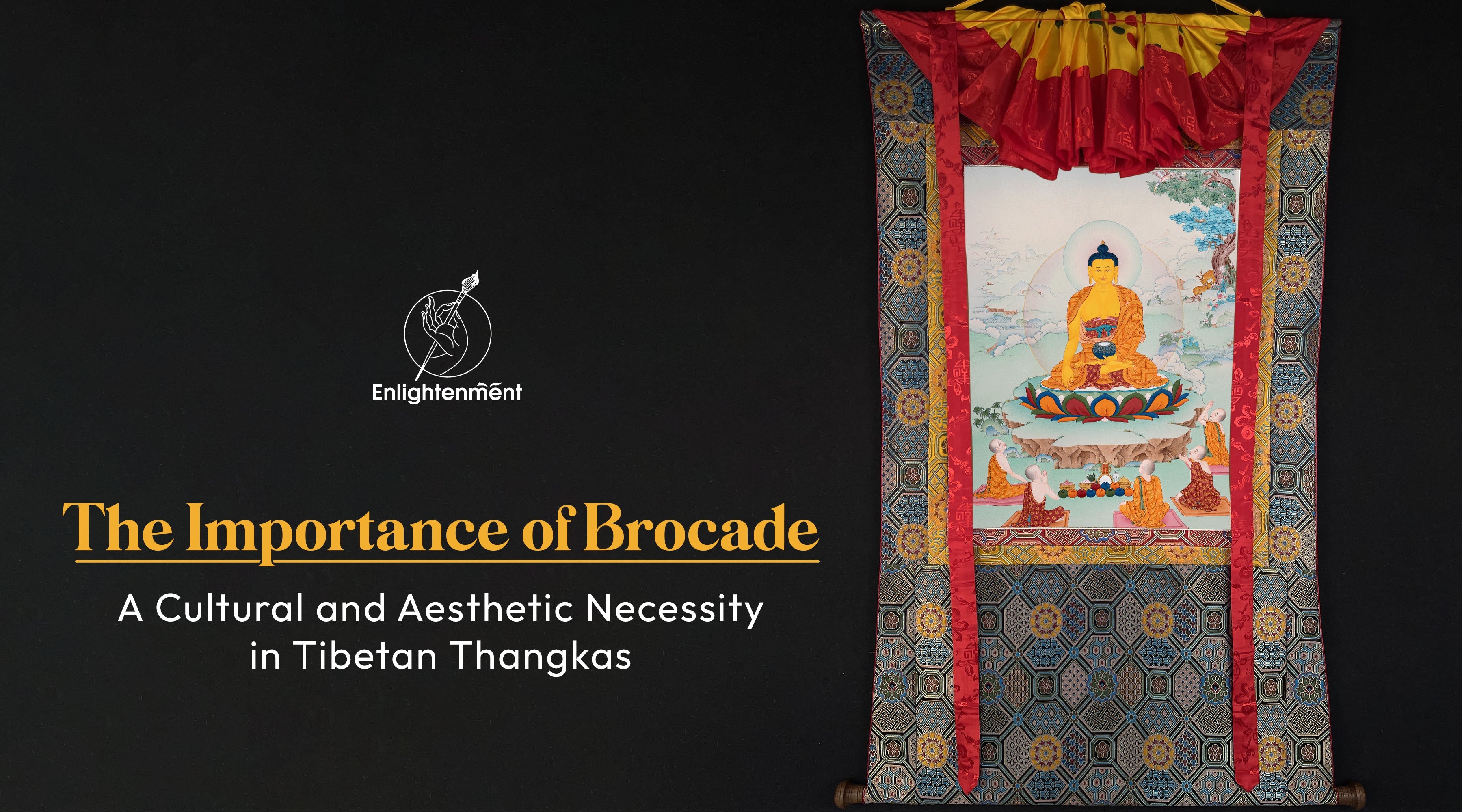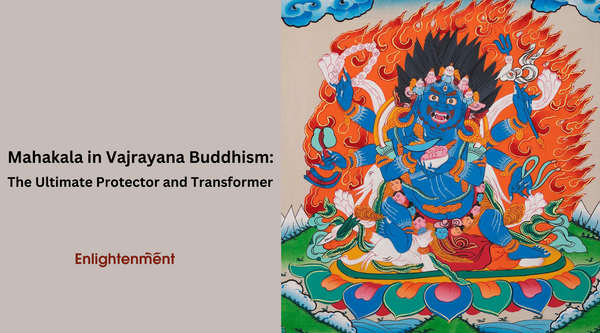The Role of Brocade in Enhancing the Sacredness of Thangkas
Thangka brocades are decorative fabric frames that surround a Tibetan thangka. They play an important role in enhancing the art's spiritual presence by providing protection and adding aesthetic appeal since they are typically made of silk or other fine materials. In essence, these frames have come to not only adorn the thanka’s aesthetic appeal but also demonstrate significant cultural, symbolic, and practical value.
Indispensable to the art of thangka, these richly embroidered thangka fabrics truly symbolize an essential connection between spirituality and artistry. In this read, explore the importance of brocade in Tibetan thangkas, detailing its cultural significance, aesthetic contribution, and role in protecting and preserving these sacred works.
Understanding Brocade: More Than Just Fabric
Brocade is an ornate, luxurious fabric woven with silk threads in a variety of multiplicity into intricate patterns and motifs on usually a metallic-sponsored background, typically ornamented with gold and silver metallic ornamentations. Originating several centuries ago in Tibet and the surrounding regions of the Himalayas, these tanka fabrics evolved into a valued art form. Hence, they are considered a kind of "sacred textile" in Tibetan culture, embodying auspiciousness, wealth, and spiritual connotation.
For thangkas, such woven decorations serve as an exquisite backdrop that complements the spiritual imagery, bringing out the colors and details of the artwork while lending it an aura of sacredness. Thus, they have become an integral part of the thangka, visually and spiritually elevating it. Here is a detailed description of each of the components labeled in the image for a Tibetan Thangka Brocade:
The Role of Brocade in Tibetan Thangkas: Cultural Symbolism and Artistic Expression
The brocade used in thangkas enhances the spiritual effect of the painting through the sumptuous framing of the divine representation. This can represent the intricate nature of Buddhist teachings through the patterns and silk texture, while the use of gold and silver threads means sacredness, abundance, and enlightenment. They are a visual and material representation of spiritual "wealth" and the sacredness of the thangka's teaching.
1. Symbol of Respect and Reverence

The silk frame acts as a symbol of respect and reverence, signifying the represented deity's importance. In so doing, the framing of those thangkas with such valuable textiles is an homage to the spiritual meaning of the artwork that the artisans and devotees made. Such framing is not an embellishment but a way of paying respect to the Buddha or bodhisattva depicted and also in recognition of the painting's sacredness. When a thangka is mounted with brocade, destinies that are more complete, dignified, and worthy of veneration are achieved.
2. Representation of Auspiciousness and Protection
In Tibetan culture, brocade is associated with auspiciousness and protection. The vibrant colors and woven patterns are thought to bring good fortune and positive energy, aligning with the purpose of thangkas, which are used to inspire and protect. By framing a thangka in this silk decoration, it is believed that they are surrounding the sacred image with auspicious energy, thereby enhancing its power as a protective charm and blessing for the space it occupies.
3. Cultural Identity and Continuity
The use of silk tapestry in thangkas portrays the rich Tibetan identity and culture, whereby each piece is associated with the skilled craftsmanship preserved through centuries. Most of the brocades used on thangkas are made with traditional patterns representing unique meanings, such as lotus flowers, which stand for purity; the endless knot, representing the interrelation of all things; and flames, symbolizing enlightenment. Therefore, thangka artists pay homage not only to Buddhist symbols but also contribute to the memory of a culture that connects contemporary Tibetan Buddhist art with its legendary past.
The Role of Brocade in Tibetan Thangkas: Aesthetic Excellence And Elegance
Brocade plays a vital role in enhancing the beauty and elegance of Tibetan thangkas. The elaborate patterns and rich texture frame the artwork as one directs his attention to the religious images, adding refinement to them. Usually made from silk, these ornate textiles do not only beautify the thangka; they symbolize spiritual abundance, a change from an ordinary painting to a sacred kind.
1. Complementary Color and Contrast
Color ranges in thangkas from deep blues to brilliant golds and reds. The decorative silk adds another layer of color and contrast to the thangka, enhancing its visual impact. The traditional pigments derived from minerals populate the palette of a thangka and tend to fade with time. Brocade, on the other hand, stays bright and lustrous, forming a contrast that highlights the colors of the painting and prevents them from receding visually. The careful selection of the appropriate brocade fabric backing will create an artwork that is striking as well as harmonious.
2. Framing and Visual Structure
The silken frame border serves as a frame of reference for the viewer, guiding and focusing their attention on the center of the image to truly engage with the deity or teaching portrayed. A thangka without brocade would be incomplete, appearing only as a painting on fabric rather than a sacred object. They not only frame the image but control the gaze, creating a natural structure of vision that allows for the deepening of the meditative quality of the work.
3. Amplification of Sacred Geometry and Symmetry

Many thangkas utilize deeply intricate sacred geometries, often with mandalas and perfectly balanced symmetrical patterns. This symmetry is further enhanced and developed with the shapes and patterns within that intricate frame. For example, if a thangka contains a mandala, the brocade may be framed in other geometric forms, such as circles or squares, to create an even greater impact from that sacred geometry. This interplay between the frame and artwork creates a visually integrated piece that elevates the spiritual symbolism through visual harmony.
Practical Purposes of Brocade
While thangka brocades hold significant cultural and aesthetic value, they also serve an important practical role in preserving and protecting thangkas.
1. Shielding Against Physical Damage
The frame of the brocade keeps the edges of the thangka from fraying and further protects it from possible damage. Tibetan thangkas are usually kept rolled up and then taken to some other place, and the fabric border frames them with sturdy material, thereby protecting the fragile painted surface. This is important in the case of thangkas, which are displayed in monasteries or carried along with religious processions.
2. Climate and Moisture Control

Another protective function of the frame extends to environmental factors. The textile fabric helps regulate moisture and temperature fluctuations that could otherwise destroy the pigments and fabric. Often made from the durable and resilient fabric of silk, this material works as a buffer that enables the thangka to withstand changes in climate, especially in the oftentimes cold and humid Himalayan environs where Tibetan Buddhism is practiced.
3. Preserving the Spiritual Energy of the Thangka
In Tibetan Buddhism, thangkas are considered sacred objects, believed to embody spiritual energy. Covering the thangka in a fine fabric retains this energy inside for a practitioner and does not leak it into the outside world. The fabric border defines a physical boundary around the painting, serving as a symbolic protectant and effectively retaining the energy, which increases its potency as a meditative object of protection. This underscores the fabric’s twofold purpose—spiritual and functional, contributing significantly to the thangka's durability.
Conclusion: Brocade as a Timeless Symbol in Tibetan Thangka Art
Brocade is far more than an accessory; it is the cultural, spiritual, and aesthetic requisite that turns these works of art into objects of veneration and beauty. It fringes each thangka with completeness, symbolizing devotion, protection, and heritage, adding to the visual attractiveness and preserving its spiritual importance. In a time when art is increasingly commercialized, the tradition of such artistic silk borders in thangkas reminds us of the deep connection between art and spirituality, making it an irreplaceable element in Tibetan thangka art.
In essence, framing Tibetan thangkas with these silk work speaks volumes beyond ornamentation; it is a deep expression of how art and culture meet at their spiritual best. Being an integral part of sacred artworks, this fabric enhances the visual appeal while shielding the spiritual core of the thangka. Rich textures, intricate patterns, and the symbolic meanings woven in the fabric speak to the respect and dedication embedded in Tibetan Buddhist practice.



